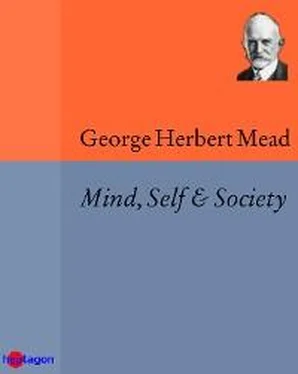I want to distinguish the differences in the use of the term »consciousness« to stand for accessibility to certain contents, and as synonymous with certain contents themselves. When you shut your eyes you shut yourself off from certain stimuli. If one takes an anesthetic the world is inaccessible to him. Similarly, sleep renders one inaccessible to the world. Now I want to distinguish this use of consciousness, that of rendering one accessible and inaccessible to certain fields, from these contents themselves which are determined by the experience of the individual. We want to be able to deal with an experience which varies with the different individuals, to deal with the different contents which in some sense represent the same object. We want to be able to separate those contents which vary from contents which are in some sense common to all of us. Our psychologists undertake definitely to deal with experience as it varies with individuals. Some of these experiences are dependent upon the perspective of the individual and some are peculiar to a particular organ. If one is color-blind he has a different experience from a person with a normal eye.
When we use »consciousness«, then, with reference to those conditions which are variable with the experience of the individual, this usage is a quite different one from that of rendering ourselves inaccessible to the world. In one case we are dealing with the situation of a person going to sleep, distracting his attention or centering his attention – a partial or complete exclusion of certain parts of a field. The other use is in application to the experience of the individual that is different from the experience of anybody else, and not only different in that way but different from his own experience at different times. Our experience varies not simply with our own organism but from moment to moment, and yet it is an experience which is of something which has not varied as our experiences vary, and we want to be able to study that experience in this variable form, so that some sort of parallelism has to be set up. One might attempt to set up the parallelism outside of the body, but the study of the stimuli inevitably takes us over into the study of the body itself.
Different positions will lead to different experiences in regard to such an object as a penny placed on a certain spot. There are other phenomena that are dependent upon the character of the eye, or the effect of past experiences. What the penny would be experienced as depends upon the past experiences that may have occurred to the different individuals. It is a different penny to one person from what it is to another; yet the penny is there as an entity by itself. We want to be able to deal with these spatially perspectival differences in individuals. Still more important from a psychological standpoint is the perspective of memory, by means of which one person sees one penny and another sees another penny. These are characters which we want to separate, and it is here that the legitimacy of our parallelism lies, namely, in that distinction between the object as it can be determined, physically and physiologically, as common to all, and the experience which is peculiar to a particular organism, a particular person.
Setting this distinction up as a psychological doctrine gives the sort of psychology that Wundt has most effectively and exhaustively presented. He has tried to present the organism and its environment as identical physical objects for any experience, although the reflection of them in the different experiences are all different. Two persons studying the same central nervous system at the dissecting table will see it a little differently; yet they see the same central nervous system. Each of them has a different experience in that process. Now, put on one side the organism and its environment as a common object and then take what is left, so to speak, and put that into the experience of the separate individuals, and the result is a parallelism: on the one side the physical world, and on the other side consciousness.
The basis for this distinction is, as we have seen, a familiar and a justifiable one, but when put into the form of a psychology, as Wundt did, it reaches its limits; and if carried beyond leads into difficulty. The legitimate distinction is that which enables a person to identify that phase of an experience which is peculiar to himself, which has to be studied in terms of a moment in his biography. There are facts which are important only in so far as they lie in the biography of the individual. The technique of that sort of a separation comes back to the physiological environment on one side and to the experience on the other. In this way an experience of the object itself is contrasted with the individual's experience, consciousness on one side with the unconscious world on the other.
If we follow this distinction down to its limits we reach a physiological organism that is the same for all people, played upon by a set of stimuli which is the same to all. We want to follow the effects of such stimuli in the central nervous system up to the point where a particular individual has a specific experience. When we have done that for a particular case, we use this analysis as a basis for generalizing that distinction. We can say that there are physical things on one side and mental events on the other. We assume that the experienced world of each person is looked upon as a result of a causal series that lies inside of his brain. We follow stimuli into the brain, and there we say consciousness flashes out. In this way we have ultimately to locate all experience in the brain, and then old epistemological ghosts arise. Whose brain is it? How is the brain known? Where does that brain lie? The whole world comes to lie inside of the observer's brain; and his brain lies in everybody else's brain, and so on without end. All sorts of difficulties arise if one undertakes to erect this parallelistic division into a metaphysical one. The essentially practical nature of this division must now be pointed out.
6. THE PROGRAM OF BEHAVIORISM
We have seen that a certain sort of parallelism is involved in the attempt to state the experience of the individual in so far as it is peculiar to him as an individual. What is accessible only to that individual, what takes place only in the field of his own inner life, must be stated in its relationship to the situation within which it takes place. One individual has one experience and another has another experience, and both are stated in terms of their biographies; but there is in addition that which is common to the experience of all. And our scientific statement correlates that which the individual himself experiences, and which can ultimately be stated only in terms of his experience, with the experience which belongs to everyone. This is essential in order that we may interpret what is peculiar to the individual. We are always separating that which is peculiar to our own reaction, that which we can see that other persons cannot see, from that which is common to all. We are referring what belongs to the experience just of the individual to a common language, to a common world. And when we carry out this relationship, this correlation, into what takes place physically and physiologically, we get a parallelistic psychology.
The particular color or odor that any one of us experiences is a private affair. It differs from the experience of other individuals, and yet there is the common object to which it refers. It is the same light, the same rose, that is involved in these experiences. What we try to do is to follow these common stimuli in through the nervous system of each of these individuals. We aim to get the statement in universal terms which will answer to those particular conditions. We want to control them as far as we can, and it is that determination of the conditions under which the particular experience takes place that enables us to carry out that control.
Читать дальше












